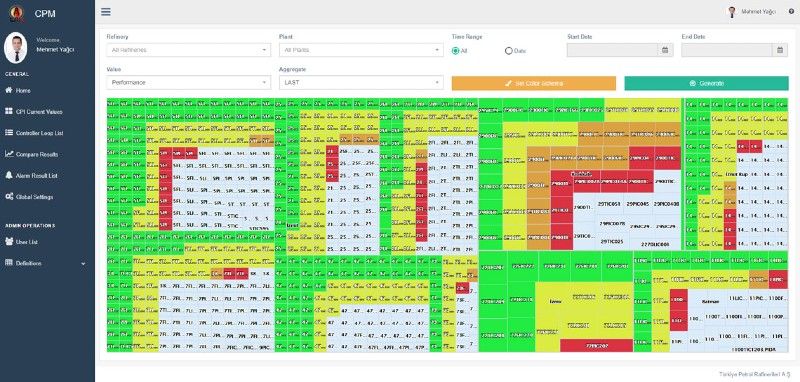Tüpraş Saves Millions of Dollars Annually with Automated Control Loop Performance Monitoring
“MATLAB saved us a significant amount of time and expense by enabling us to develop our own software in-house. It also enabled us to save millions of dollars in costs that would have resulted from poor controller performance.”
Challenge
Automate the monitoring and maintenance of almost 6000 control loops across four refineries
Solution
Use MATLAB to develop and test performance assessment and analysis algorithms that incorporate signal processing, spectral analysis, pattern recognition, and autoregressive models
Results
- Up to $20 million saved annually
- 250 engineer-days of manual effort eliminated
- Cost-saving solution developed in-house
Tüpraş operates four refineries with a total yearly crude oil processing capacity of more than 28 million tons, making it Turkey’s largest industrial company and one of the 10 largest refinery companies in Europe. Tüpraş refineries are equipped with advanced process control systems in addition to approximately 5900 proportional-integral-derivative (PID) control loops. If these loops are not regularly tuned to account for changes in process dynamics, the controllers are no longer able to catch desired set-point values in an optimal manner, reducing production while increasing safety risk and costs.
The Tüpraş R&D center chemical engineers, Mehmet Yagci and Gizem Kusoglu Kaya have developed an automated system for monitoring and identifying control-loop performance problems that saves the company an estimated $12 million to $20 million each year. The team used MATLAB® to accelerate the development and testing of the system’s core algorithms.
“MATLAB saved us a great deal of time in writing performance assessment and other algorithms,” says Mehmet Yagci, modeling and process control superintendent at Tüpraş. “With just a few lines of code we can estimate the performance of a control loop. We have complete confidence in the MATLAB functions that we use because we know they are thoroughly tested and widely used in industrial applications.”
Challenge
Friction, aggressive tuning, and external disturbances all contribute to diminished performance. Until recently, advanced process control engineers at Tüpraş could spend up to four hours monitoring a single control loop for such problems. With 5900 loops and more than 17,000 parameters to be checked and adjusted, monitoring the loops took thousands of engineer-hours each year.
Tüpraş evaluated several packaged third-party solutions. With prices based on the number of loops to be monitored, these solutions would have cost the company hundreds of thousands of dollars. More important to Tüpraş engineers, the software was difficult to customize.
Tüpraş decided to build their own solution in-house. After a comprehensive survey of papers on state-of-the-art control loop monitoring techniques, the team identified algorithms that would be essential to their solution, including performance assessment, oscillation analysis, and control valve analysis. To minimize development time, the company’s chemical engineers wanted to implement and test these algorithms themselves rather than write requirements for implementation by a separate software engineering or IT team. After completing the algorithm design phase, they handed the software architecture and specifications off to the IT team, who would build the software according to company standards.
Solution
Tüpraş engineers used MATLAB to develop and verify the core algorithms for automated control-loop monitoring software.
The team selected one refinery unit as a pilot for algorithm development. Working in MATLAB, they built autoregressive models for each of the controllers in this unit using minimum variance control principles. They then developed a performance assessment algorithm that used the model to identify control loops that were not performing within normal operating ranges.
Once the team had an algorithm to identify poorly performing control loops, they used MATLAB and Signal Processing Toolbox™ to develop algorithms that apply spectral analysis and cross-correlation estimation to identify the source of oscillations caused by aggressive control-loop tuning.
The engineers also developed algorithms that analyze nonlinearities in the system for cases where static friction in a valve made it impossible to determine the source of oscillations. These algorithms perform bicoherence analysis to examine the interaction between frequencies detected in the system and isolate the source oscillations.
After that, the team developed algorithms to address control valve problems caused by static friction. These algorithms apply pattern recognition techniques to detect static friction and measure its effect on a control loop.
Finally, they combined all the algorithms to create an end-to-end process monitoring and root-cause analysis solution that would identify poor-performing control loops and the reasons for performance degradations.
After testing and verifying all the algorithms against data from multiple refinery units, Tüpraş software engineers used the MATLAB code as a basis for implementing a C# version, a standard company practice for deploying enterprise-wide systems.
Results
- Up to $20 million saved annually. “We estimate that a single poorly performing control loop can cost the company $10,000 each year,” says Yagci. “Based on that estimate and on industry averages, we concluded that the performance assessment and control-loop analysis algorithms we developed in MATLAB save Tüpraş from $12 million to $20 million each year.”
- 250 engineer-days of manual effort eliminated. “Manual analysis of 5900 control loops and more than 17,000 loop parameters took our process control engineers 250 days of effort each year,” notes Yagci. “With the algorithms we developed and tested in MATLAB, we have automated this process, freeing the engineers to work on other projects.”
- Cost-saving solution developed in-house. “MATLAB enabled a small team of chemical engineers to use their expertise and process knowledge to implement and test algorithms directly rather than relying on a separate team of programmers,” says Yagci. “Developing our own solution in-house also eliminated the need for third-party solutions costing from $300,000 up to $1 million.”
